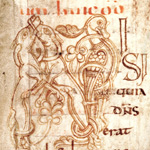Above: Zoomorphic Initial (detail) and Initial P (detail), From the Corbie Psalter, Corbie, France, early 9th century. Bibliothèques d’Amiens Métropole, MS 18C
One point I have stressed in both the exhibition and its accompanying catalogue is the intimate relationship that existed in the Middle Ages between drawing and the written word. Few works better illustrate this point than the Corbie Psalter, created around 800. This endlessly fascinating book contains both the Psalms and the Canticles (the songs in the Bible that are not Psalms). Its illustrations consist entirely of remarkably inventive initials for the first letter of the first word of each text.
In many cases, we understand the artists and the scribes of a medieval book to have had separate tasks: the scribe wrote the text on the ruled lines of the page, leaving space for an illustration to be added by the artist. In the Corbie Psalter, however, the scribes were also the artists, and they drew as they wrote. The illustrations clearly arose from their consideration of the text, and the text is laid down on the page in consideration of the illustration.
How can we tell from the existing book that the scribes-artists worked in this manner? Have a look at the initial for Psalm 123. The text, in Latin, begins “Nisi quia dominus erat in nobis. . .” (”If it had not been that the Lord was with us. . .”). The artist clearly created the letter “N” first, using two hounds and a bird, and then adjusted the rest of the phrase to the initial’s contours. Note how the paw of one of the intertwined hounds carefully perches on the “in” of the first full line of text and the way in which the “d” of “dominus” actually ascends right into the illustration. In order to achieve this, the artist must have created the image before writing in the text.
While the artist who illustrated Psalm 123 chose a zoomorphic, or animal-shaped, initial, in other cases the drawing was meant to enhance the readers’ experience or understanding of the text. The illustration for one psalm tells the story of young David’s defeat of the giant Goliath. Little David, with his slingshot full of stones, rests inside the circle of the “P” of the word “Pusillus” (”small”), while the mighty Goliath forms the letter’s long stem. The rest of the text then continues alongside the letter. The psalm and its illustration are thus marvelously integrated. Here again, writing and drawing are a seamless enterprise, with each informing the other.
—Melanie Holcomb
Tags: Corbie Psalter, Psalm 123, zoomorphic


